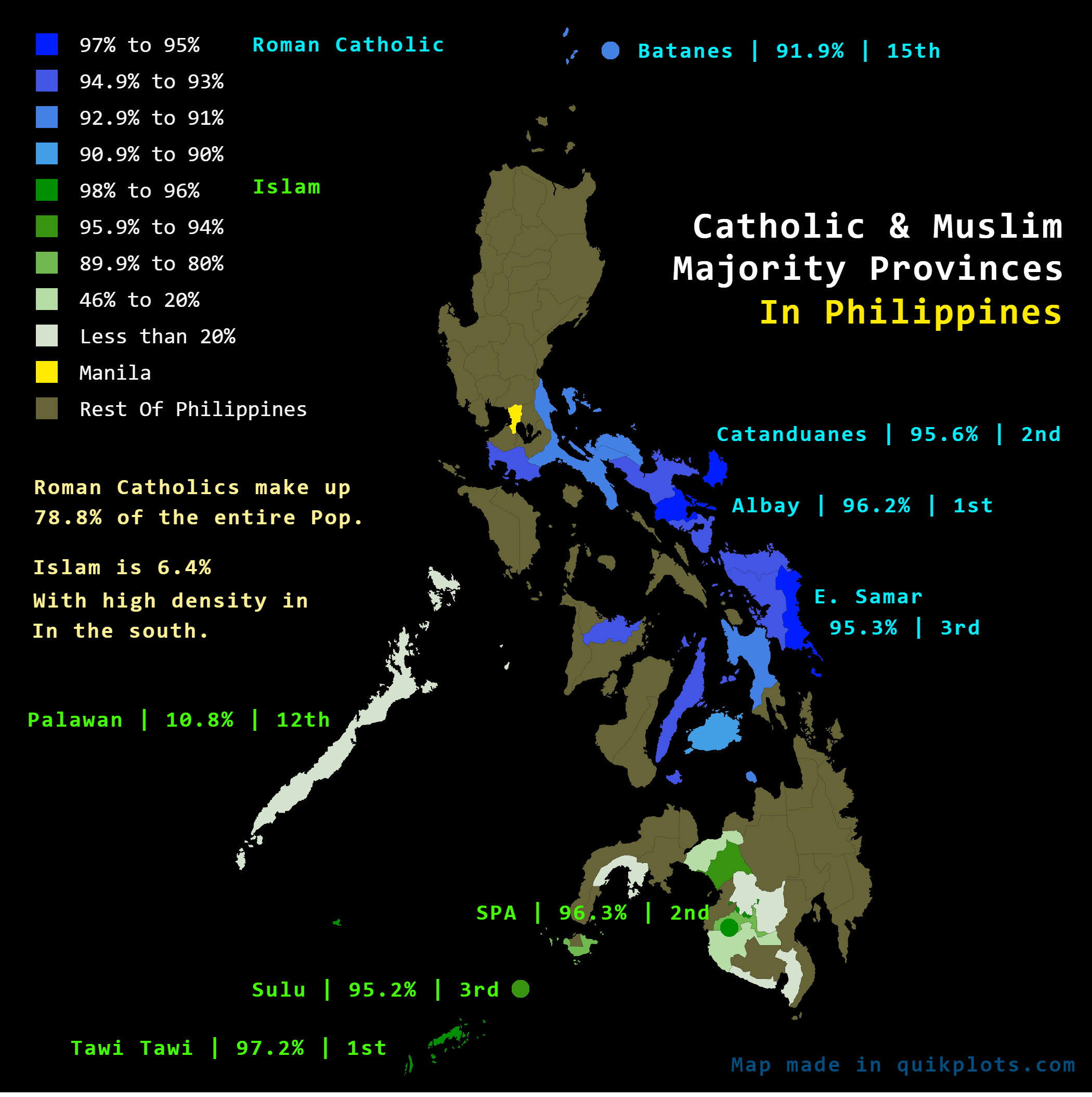Catholic and Muslim Majority Provinces Map in the Philippines


Marcus Rodriguez
Historical Geography Expert
Marcus Rodriguez specializes in historical cartography and geographic data analysis. With a background in both history and geography, he brings unique...
Geographic Analysis
What This Map Shows
The "Catholic & Muslim Majority Provinces In The Philippines" map visually delineates the religious demographics of the country, highlighting a clear north-south divide. On one side, the provinces predominantly identify as Catholic, while on the other, a significant portion of the population practices Islam. This map is not just a collection of colors and lines; it tells a story of cultural influences, historical migrations, and socio-political dynamics that have shaped the archipelago's identity. The southern provinces, particularly influenced by the historical interactions with Indonesia and Malaysia, showcase a rich tapestry of Islamic culture and traditions.
Deep Dive into Religious Demographics in the Philippines
The Philippines is a unique case study in Southeast Asia when it comes to religious affiliations. With over 80% of the population identifying as Roman Catholic, the nation is one of the largest Catholic populations in the world. This strong Catholic presence can be traced back to Spanish colonization in the 16th century, which firmly established Catholicism in Filipino society. However, what's fascinating is the significant Muslim population concentrated in the southern regions, particularly in the Bangsamoro Autonomous Region in Muslim Mindanao (BARMM).
Historically, Islam was introduced to the Philippines in the 14th century, primarily through traders from the Malay Archipelago. The southern provinces, including Sulu, Basilan, and Maguindanao, are predominantly Muslim, with rich traditions and cultural practices that have evolved over centuries. According to the 2020 Census of Population and Housing by the Philippines Statistics Authority, provinces like Sulu and Lanao del Sur have Muslim majorities, showcasing the enduring influence of Islamic culture in these regions.
The differences in religious demographics are not just numbers; they affect social structures, local governance, and even economic opportunities. For instance, the predominantly Muslim provinces have distinct governance systems, often influenced by Sharia law and local customs, which differs from the Catholic-majority provinces where secular governance prevails. This duality has led to different developmental paths, with the southern provinces often facing challenges such as poverty and conflict compared to the more economically developed northern regions.
Regional Analysis
When we break down the provinces as depicted in the map, we can see stark contrasts in demographics and cultural practices. In the northern provinces like Luzon, Catholicism thrives in everyday life—from the vibrant celebrations of fiestas to the prevalence of Catholic schools and institutions. Provinces such as Ilocos Norte and Cagayan Valley display a strong Catholic identity, which is reflected in their local customs, holidays, and community events.
In contrast, the southern provinces, particularly in Mindanao, present a different cultural landscape. Here, cities like Zamboanga and Cotabato are melting pots of Muslim culture, infused with traditions that celebrate Islamic teachings. The Bangsamoro region is a prime example, where local governance structures are designed to cater to the unique needs of the Muslim population, often incorporating elements of their historical governance systems.
Interestingly, while the north remains largely Catholic, there is a growing awareness and interest in Islam among some sectors in northern provinces, leading to interfaith dialogues and cultural exchanges. This dynamic underscores not just the divide, but also the potential for unity through understanding and respect.
Significance and Impact
Understanding the religious demographics of the Philippines is crucial for several reasons. Firstly, it helps in grasping the complex socio-political landscape of the nation. The historical tensions between the Catholic and Muslim groups have often led to conflicts, and recognizing these divides is key to fostering peace and development. Furthermore, as the Philippines continues to grapple with issues of poverty and governance, the interplay between these religious identities can inform policies aimed at inclusive development.
Moreover, current trends indicate a gradual but noticeable rise in interfaith initiatives, which aim to bridge the gap between these two major religious groups. This is particularly significant as the country moves towards a more inclusive society, promoting unity amid diversity. The future of the Philippines may depend on its ability to embrace its multifaceted identity, and understanding the religious map is a step toward that goal.
The map serves as a reminder of the rich cultural heritage and the potential for collaboration between diverse groups in the Philippines. As the country strides into the future, recognizing and respecting these differences will be vital for harmony and progress.
Visualization Details
- Published
- September 29, 2025
- Views
- 60
Comments
Loading comments...